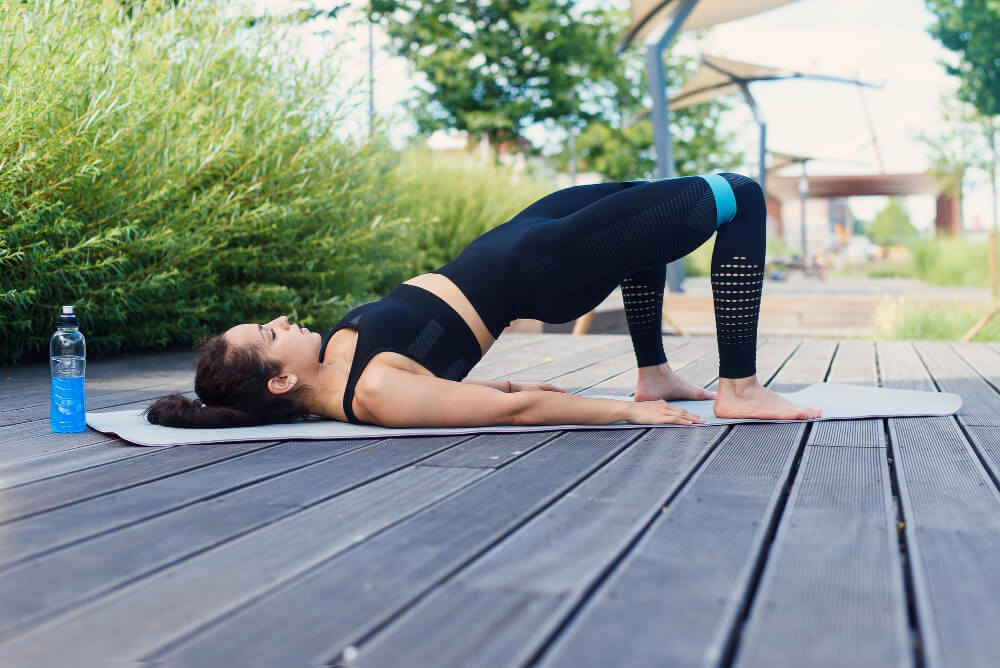The pelvic floor muscles are a group of muscles that support the pelvic organs and span the bottom of the pelvis. Strengthening these muscles is essential for maintaining proper bladder and bowel function and can help reduce the risk of pelvic organ prolapse.
Many people are unaware of these muscles’ role in overall well-being, but the benefits of maintaining a strong pelvic floor can be significant for both men and women.
Targeted exercises are a proven method for enhancing the strength and endurance of the pelvic floor muscles.
Pelvic floor muscle training, known as Kegel exercises, is the cornerstone of strengthening these critical muscles.
Beyond Kegels, several other exercises, such as squats, bridges, and pelvic tilts, contribute to a stronger pelvic floor. Each exercise targets the pelvic floor muscles differently, allowing for a comprehensive strengthening routine.
Incorporating deep belly breathing further assists in engaging and relaxing the pelvic floor, which can enhance the effectiveness of the exercises.
Key Takeaways
- Strengthening the pelvic floor muscles is crucial for bladder and bowel control.
- Various exercises, including Kegels and squats, target the pelvic floor.
- Deep belly breathing can improve the performance of pelvic floor exercises.
Understanding the Pelvic Floor Muscles
The pelvic floor muscles (PFM) are a complex group of muscles that extend from the pubic bone to the coccyx and form the base of the pelvic cavity. These muscles support pelvic organs, including the bladder, uterus, and rectum.
Functionally, they can be broken down into three main components:
- Support: They provide a steady base for the pelvic organs, preventing prolapse.
- Sphincteric: They control the release of urine and feces.
- Sexual: These muscles contribute to sexual sensation and arousal.
A key aspect of maintaining pelvic floor health is through regular exercise. Benefits from such exercises include:
- Improved bladder and bowel control
- Reduced risk of pelvic organ prolapse
- Enhanced recovery post-childbirth
Research has indicated that pelvic floor muscle training is effective in the treatment of female stress urinary incontinence. However, engaging and strengthening these muscles properly is essential for efficacy.
Training often includes kegel exercises, which involve squeezing and holding the muscles that one would use to stop urine flow. These should emphasise the contraction and relaxation phases to ensure the muscles are fully engaged throughout their range of motion.
For those seeking to enhance their PFM function, increasing awareness of muscle function may play an important role, as detailed in studies exploring improvements in pelvic floor dysfunction. With correct training, individuals may see remarkable improvements in their pelvic floor strength and endurance, contributing to overall pelvic health.
Kegel Exercises
Kegel exercises are fundamental for strengthening the pelvic floor muscles, which support the uterus, bladder, small intestine, and rectum.
Identifying the Correct Muscles
One must first identify the pelvic floor muscles to perform Kegel exercises effectively. These muscles are engaged when one attempts to stop urination midstream or avoid passing gas. Health professionals might use biofeedback techniques to aid individuals in identifying the correct muscles for Kegels.
The Basic Kegel
Step 1: Empty the bladder before performing the exercises.
Step 2: Tighten the pelvic floor muscles and hold the contraction for five seconds, then relax for another five seconds.
Repeat: Aim to complete 10 repetitions three times a day.
Advanced Kegel Variations
Upon mastering the basic Kegel, individuals can explore advanced variations to increase muscle strength further.
Six useful squat hacks to burn body fat & shape your legs – fasterThese can include holding the contractions for longer periods, typically up to ten seconds, or integrating these exercises into various positions, such as standing or squatting.
Incorporating tools like vaginal weights or biofeedback devices may offer additional benefits, with research suggesting that ongoing practice can lead to improvements in conditions such as genuine stress incontinence.

Squats
Squats are a fundamental exercise that strengthens the legs and glutes and enhances pelvic floor muscle strength.
A proper squat engages the pelvic floor muscles, benefiting both men and women, particularly urinary function and core stability.
Basic Squat Technique
To perform a basic squat:
- Stand with feet hip-width apart, toes facing forward.
- Keep the back straight and chest lifted as you bend the knees, lowering the body as if sitting back into a chair.
- Ensure the knees do not go past the toes.
- Focus on tightening the pelvic floor muscles as you lower down.
- Press through the heels to return to standing, continuing to engage the pelvic floor muscles.
It’s vital that individuals maintain proper form to prevent injury and effectively target the pelvic floor muscles during the exercise.
Research indicates that performing the recommended pelvic floor exercises can improve pelvic floor disorders.
Squat Variations
Several squat variations can further engage the pelvic floor muscles, providing different levels of intensity and focus:
- Sumo Squats: With a wider stance and toes pointed out, this variation targets the inner thighs and the pelvic floor.
- Squat Pulses: Staying in the squat position and making small up-and-down movements increases the muscles’ tense time.
- Squat Holds: Maintaining the squat position for a set period can improve muscular endurance.
- Single-leg Squats require more balance and strength, fully engaging the core and pelvic floor muscles.
Each of these variations should be performed with the same attention to pelvic floor engagement as the basic squat.
A study demonstrated that a squatting-based pelvic exercise regime can remediate conditions such as day/night enuresis and bowel dysfunction in children, shedding light on the broad utility of squats in pelvic floor strengthening programs.

Bridge Exercises
Bridge exercises are vital for strengthening the pelvic floor muscles. They also engage the glutes and hamstrings, enhancing core stability and muscular coordination.
The Basic Bridge
The Basic Bridge targets the glutes, lower back, and pelvic floor muscles.
It is executed by lying on one’s back with knees bent and feet flat, about hip-width apart. The individual then lifts their hips off the ground, creating a straight line from the knees to the shoulders.
This position should be held for several seconds, and the hips are then lowered back to the floor. It is recommended to perform 10 to 15 repetitions of this exercise.
Bridge Variations
Multiple bridge variations challenge the pelvic floor muscles continually.
One notable variation is the Single-Leg Bridge, in which individuals perform the bridge with one leg raised. This introduces more difficulty and promotes unilateral pelvic floor strength.
Moreover, incorporating a Stability Ball can increase the engagement of the pelvic floor and core muscles for improved efficacy.
A comprehensive analysis published in Evidence-Based Physical Therapy for the Pelvic Floor supports the idea that performing these exercises consistently can improve pelvic floor muscle function.
These bridge exercises are beneficial postpartum and equally important for general pelvic floor health.

Pelvic Tilt
The pelvic tilt exercise is instrumental in strengthening the pelvic floor muscles. By correcting the anterior pelvic tilt and practising posterior pelvic tilt, individuals can improve muscle coordination and alleviate discomfort associated with imbalances.
Anterior Pelvic Tilt Correction
Anterior pelvic tilt occurs when the front of the pelvis drops about the back. This often results in a pronounced lower back curve and can potentially lead to discomfort.
An individual strengthening exercise targeting this imbalance can relieve lower back pain while improving pelvic angle and lumbar range of motion.
- Lie on your back with your knees bent and your feet flat on the ground, keeping your spine neutral.
- Tighten the abdominal muscles and buttocks while gently pressing the lower back into the floor.
- Hold for five seconds, and then return to the starting position.
- Perform three sets of ten repetitions daily for optimal results.
Posterior Pelvic Tilt Practice
Practising posterior pelvic tilt helps strengthen the lower abdominal muscles and the pelvic floor by the reverse mechanism of anterior pelvic tilt, where the pelvis is rotated backward.
- Begin seated on a ball or chair with feet planted firmly on the floor.
- Contract your pelvic floor muscles as if trying to interrupt the urine flow.
- While maintaining the contraction, rock the pelvis backward to decrease the lower back curve.
- Aim for ten repetitions, repeating the exercise in sessions scattered throughout the day.
This exercise, when combined with other activities, has been shown to result in improvements in pelvic floor muscle contraction for a majority of participants.

Deep Belly Breathing
Deep belly breathing, or diaphragmatic breathing, is a foundational exercise that can significantly benefit pelvic floor strength.
Starting Position: Individuals should begin in a comfortable, relaxed position, such as lying down with knees bent or sitting comfortably with a straight back.
Inhalation: As they inhale, they focus on allowing the belly to rise while keeping the chest relatively still, indicating the diaphragm’s downward movement, which decreases pressure on the PFMs.
Exhalation: Upon exhaling, the belly falls naturally, and the pelvic floor muscles gently lift—this shouldn’t be forced but rather a natural recoil.
By incorporating deep belly breathing into their routine, individuals can promote relaxation of the deep abdominal muscles, which in turn supports the health and function of the pelvic floor.
Regular practice may not only improve pelvic floor strength but also aid in reducing stress urinary incontinence.
Frequently Asked Questions
Understanding the right exercises to strengthen the pelvic floor is key to improving core stability, bladder control, and sexual function. These exercises are beneficial for both women and men when done consistently and correctly.
What are effective exercises for women to strengthen the pelvic floor?
Pelvic floor muscle training is a proven effective method for women. Exercises include Kegels, which involve tightening and holding the pelvic floor muscles.
Another exercise is squats that incorporate pelvic floor activation.
Which exercises can help to improve pelvic floor strength quickly?
To expedite improvement in pelvic floor strength, it is recommended to incorporate a mix of quick contractions and sustained holds in Kegel exercises. Consistency and proper technique are crucial for quick results.
Can you list some standing exercises that target the pelvic floor muscles?
Standing exercises that target the pelvic floor include standing squats, leg lifts, and sumo squats. These movements naturally engage the pelvic floor muscles as part of the body’s effort to maintain stability and balance.
How can men specifically strengthen their pelvic floor muscles through exercise?
Men can perform pelvic floor muscle exercises similar to women’s, focusing on Kegels and pelvic lifts. Men need to identify and isolate the correct muscles, which lie between the base of the penis and the anus.
What is the best way to perform Kegel exercises for pelvic floor health?
The best way to perform Kegel exercises is to correctly locate the muscles by stopping urination midstream. Once identified, squeeze these muscles for three seconds, then relax for three, aiming for three sets of ten repetitions daily.
Are there specific pelvic floor exercises that aid in the management of prolapse?
Pelvic floor exercises like deep squats, bird dogs, and pelvic tilts are effective for prolapse management.
Perform these exercises gently and focus on the correct technique to prevent further descent of pelvic organs.
You can also follow me on YouTube for the latest, science-backed research on health, weight, and weight training and an endless supply of healthy recipes.
Download your low-carb, high-protein dinner recipe book with two bonuses here.
I appreciate your support.
